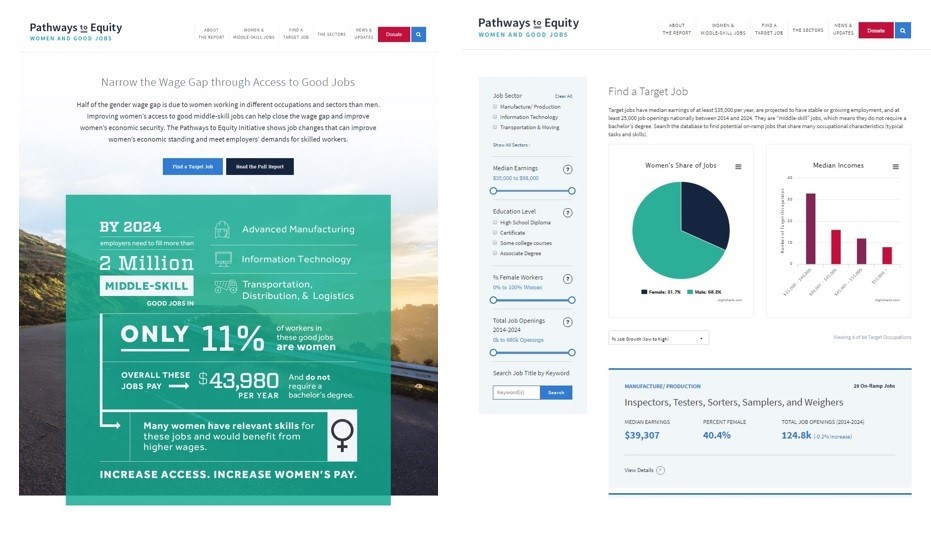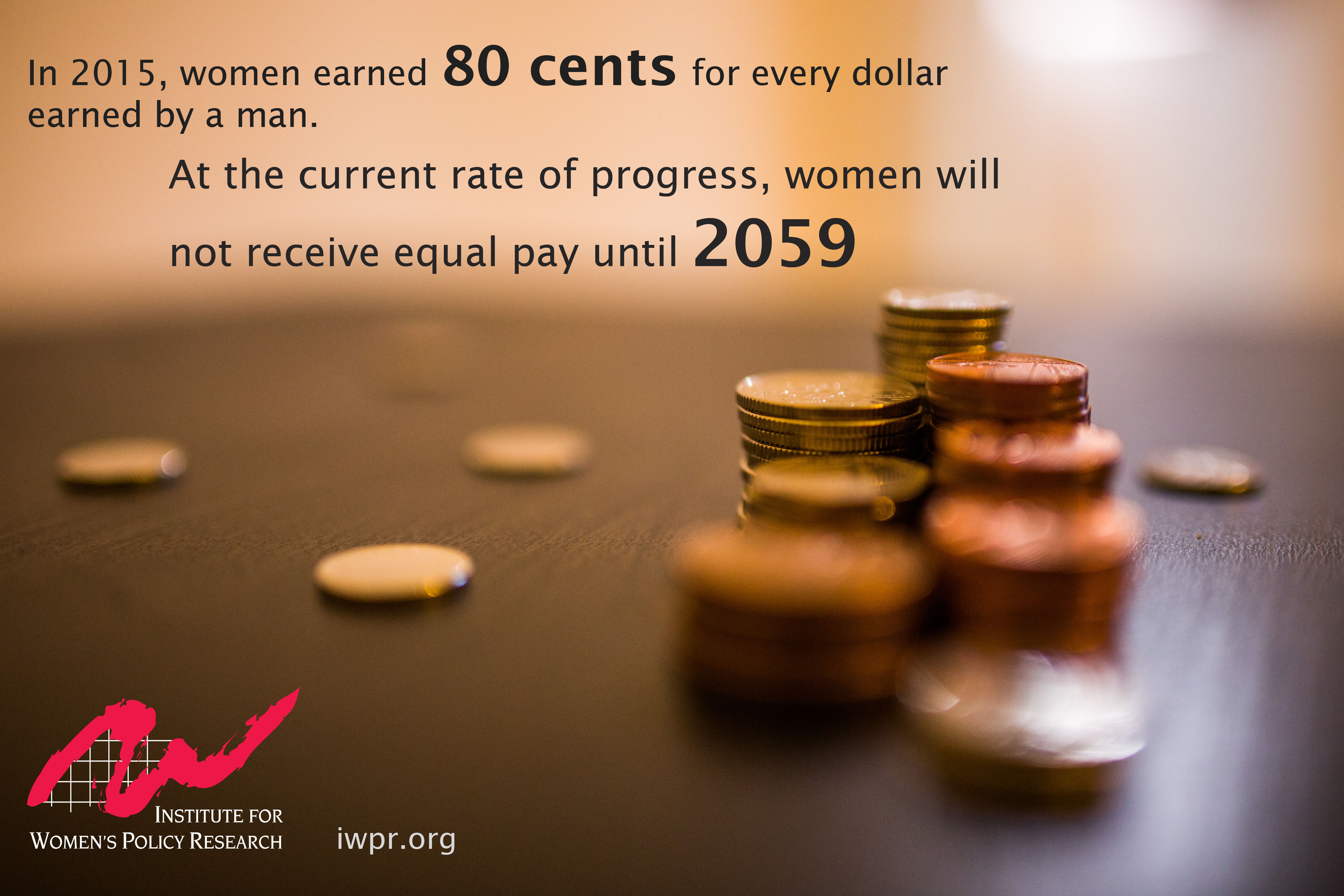In advance of tonight’s first presidential debate, IWPR helps you get up to speed on these five top women’s policy issues:
- Improving Women’s Access to Good Jobs Can Narrow the Wage Gap
- A College Affordability Challenge: Declining Availability of Campus Child Care
- The Significance of the Gender Wage Gap; Wages among Women of Color are Especially Low
- Breadwinner Mothers are Common in Every State, but Policies Need to Catch Up
- The Evidence-Based Case for Paid Sick Days and Paid Leave Policies
1. Improving Women’s Access to Good Jobs Can Narrow the Wage Gap
>> Read the report, Pathways to Equity: Narrowing the Wage Gap by Improving Women’s Access to Good Middle-Skill Jobs or the Executive Summary.
Half of the gender wage gap is due to women working in different occupations and sectors than men. Improving women’s access to good middle-skill jobs—in growing sectors, such as manufacturing, IT, and transportation—can help close the wage gap and improve women’s economic security.
Visit womenandgoodjobs.org, to read the report and explore an interactive, searchable database of middle-skills jobs, which helps users identify pools of skilled women workers who could be tapped to fill shortages, ensuring that the economy benefits from the talent of its whole workforce.
2. A College Affordability Challenge: Declining Availability of Campus Child Care
>> Read the briefing paper, Child Care for Parents in College: A State-by-State Assessment
As nearly 5 million undergraduate students raising children return to college this fall, a new IWPR state-by-state and national analysis finds that campus child care is declining in 36 states across the country, and that many states have rules making it difficult for students to get child care subsidies.
For the nearly 9 in 10 (88 percent) student parents living in or near poverty, paying for child care can be an insurmountable obstacle. IWPR’s analysis finds that, rather than assisting students with the high cost of child care, 11 states require college students to also be employed to be eligible for child care subsidies. In 3 states—Arizona, Kentucky, and Washington—parents are required to work at least 20 hours per week in addition to attending school, an amount proven to diminish rates of college completion among students overall, in order to be eligible for subsidies.
3. The Significance of the Gender Wage Gap; Wages among Women of Color are Especially Low
>> Read IWPR’s New Resources on Pay Equity & Discrimination, including Five Ways to Win an Argument about the Gender Wage Gap
IWPR’s updated fact sheet clarifies the most common myths about gender wage gap statistics. IWPR’s researchers note that a pay gap of 79.6 percent accurately describes the pay inequality between men and women in the labor force and reflects a variety of different factors, including: discrimination in pay, recruitment, job assignment, and promotion; lower earnings in occupations mainly done by women; and women’s disproportionate share of time spent on family care, including that they—rather than fathers—still tend to be the ones to take more time off work when families have children.
In fact, the annual wage ratio of 80 percent is actually a moderate estimate of gender pay inequality. Women of color fare much worse, with Black women making 63.3 percent of what White men earn per year and Hispanic women making 54.4 percent.
In addition, IWPR has found:
- Women earn less than men in almost every occupation and are four times more likely than men to work in jobs with poverty-level wages.
- If current trends continue, women will not receive equal pay until 2059, according to a related IWPR analysis of trends in earnings since 1960.
- If women earned the same as comparable men—men who are of the same age, have the same level of education, work the same number of hours, and have the same urban/rural status—poverty among working women would be cut in half and the US economy would grow by $482.2 billion.
4. Breadwinner Mothers are Common in Every State, but Policies Need to Catch Up
>> Read the quick figures, Breadwinner Mothers by Race/Ethnicity and State
A new IWPR national and state-by-state analysis of breadwinner moms finds that four in five Black mothers and two in three Native American mothers are breadwinners, compared with fewer than half of White and Asian/Pacific Islander mothers. Breadwinner moms are either raising children on their own or contributing at least 40 percent of a married couple’s earnings. The majority of Black, Native American, and Hispanic breadwinner moms are single and raising a family on their own, while the majority of White and Asian/Pacific Islander breadwinner mothers are married.
As the share of breadwinner mothers increases, another IWPR analysis found that women’s wages fell 1.6 percent between 2004 and 2014, with Black, Native American, and Hispanic women’s earnings falling around three times as much as women’s earnings overall. (Read the analysis with state data for Black women and Native American women.)
5. The Evidence-Based Case for Paid Sick Days and Paid Leave Policies
>> Read the briefing paper, Paid Sick Days Benefit Employers, Workers, and the Economy
Four in 10 American workers lack access to paid sick days, with access less likely among Hispanic workers and workers in low-wage and food service jobs. A recent IWPR briefing paper compiles all available social science and policy research, which show that paid sick days are associated with benefits to employers—including reduced contagion in the workplace, improved productivity, decreased workplace injuries, and lower employee turnover—and employment benefits to workers, including greater job stability and labor force attachment.
>> Read the report, Paid Parental Leave in the United States: What the Data Tell Us about Access, Usage, and Economic and Health Benefits
Another IWPR report compiles available research and data on the access to paid parental leave and the benefits of such a policy. A growing body of research suggests that paid family leave increases labor market attachment, economic security, and the health and welfare of families and children, and has the potential to help businesses thrive, reduce spending on public benefits programs, and promote economic growth and competitiveness.
Follow @IWPResearch on Twitter and Facebook.
To view more of IWPR’s research, visit IWPR.org




